张兴盼-201871010131《面向对象程序设计(Java)》第七周学习总结
|
项目 |
内容 |
|
这个作业属于哪个课程 |
http://www.cnblogs.com/nwnu-daizh/ |
|
这个作业的要求在哪里 |
https://www.cnblogs.com/nwnu-daizh/p/11654436.html |
|
作业的学习目标 |
(1) 掌握四种访问权限修饰符的使用特点; (2) 掌握Object类的用途及常用API; (3) 掌握ArrayList类的定义方法及用法; (4)掌握枚举类定义方法及用途; (5)结合本章实验内容,理解继承与多态性两个面向对象程序设计特征,并体会其优点。 |
实验内容和步骤
实验1:在“System.out.println(...);”语句处按注释要求设计代码替换...,观察代码录入中IDE提示,以验证四种权限修饰符的用法。
程序代码如下:
|
1 2 3 4 5 6 7 8 9 10 11 12 13 14 15 16 17 18 19 20 21 22 23 24 25 26 27 28 29 30 31 32 33 34 35 36 37 38 39 40 41 42 43 44 |
class Parent { private String p1 = "这是Parent的私有属性"; public String p2 = "这是Parent的公有属性"; protected String p3 = "这是Parent受保护的属性"; String p4 = "这是Parent的默认属性"; private void pMethod1() { System.out.println("我是Parent用private修饰符修饰的方法"); } public void pMethod2() { System.out.println("我是Parent用public修饰符修饰的方法"); } protected void pMethod3() { System.out.println("我是Parent用protected修饰符修饰的方法"); } void pMethod4() { System.out.println("我是Parent无修饰符修饰的方法"); } } class Son extends Parent{ private String s1 = "这是Son的私有属性"; public String s2 = "这是Son的公有属性"; protected String s3 = "这是Son受保护的属性"; String s4 = "这是Son的默认属性"; public void sMethod1() { System.out.println( );//分别尝试显示Parent类的p1、p2、p3、p4值 System.out.println("我是Son用public修饰符修饰的方法"); } private void sMethod2() { System.out.println("我是Son用private修饰符修饰的方法"); } protected void sMethod() { System.out.println("我是Son用protected修饰符修饰的方法"); } void sMethod4() { System.out.println("我是Son无修饰符修饰的方法"); } } public class Demo { public static void main(String[] args) { Parent parent=new Parent(); Son son=new Son(); System.out.println( ); //分别尝试用parent调用Paren类的方法、用son调用Son类的方法 } } |
运行结果如下:
分别尝试用parent调用Paren类的方法


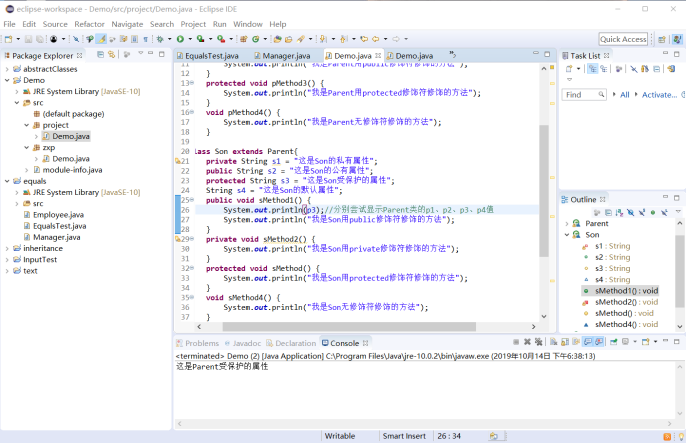
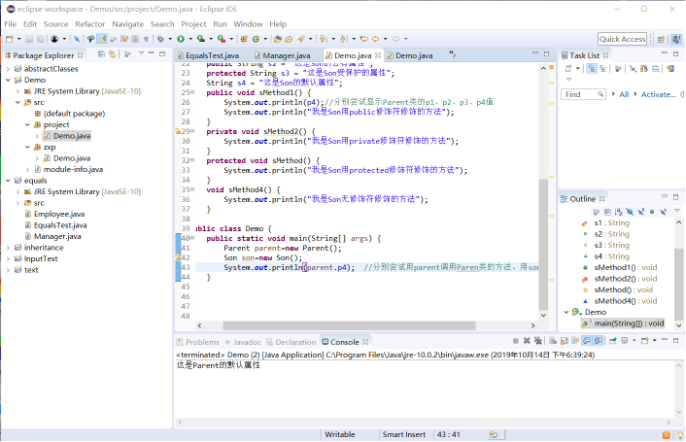
用son调用son类
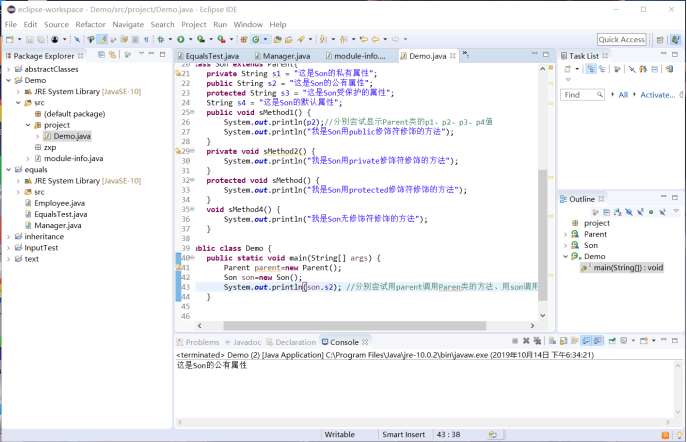
下面是将parent类放入以自己名字命名的包里面
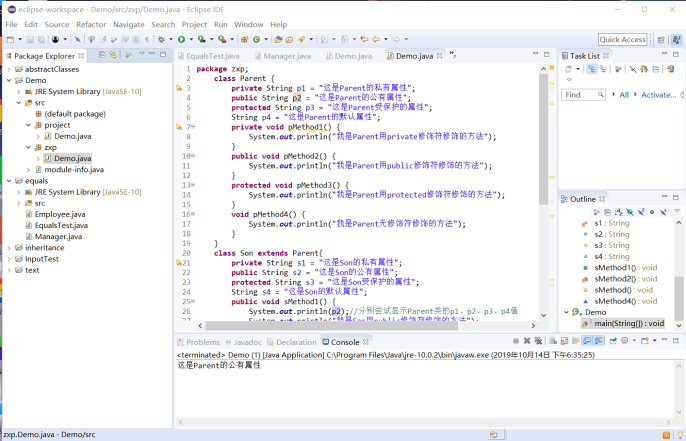
这个实验主要是让我们了解关于四种访问权限的修饰符:
|
位置 |
private |
默认 |
protected |
public |
|
同一个类 |
是 |
是 |
是 |
是 |
|
同一个包里的类 |
否 |
是 |
是 |
是 |
|
不同包内的子类 |
否 |
否 |
是 |
是 |
|
不同包并且不是子类 |
否 |
否 |
否 |
是 |
实验2:导入第5章以下示例程序,测试并进行代码注释。
测试程序1:
a)运行教材程序5-8、5-9、5-10,结合程序运行结果理解程序(教材174页-177页);
b) 删除程序中Employee类、Manager类中的equals()、hasCode()、toString()方法,背录删除方法,在代码录入中理解类中重写Object父类方法的技术要点。
Employee类代码如下:
|
1 2 3 4 5 6 7 8 9 10 11 12 13 14 15 16 17 18 19 20 21 22 23 24 25 26 27 28 29 30 31 32 33 34 35 36 37 |
package equals; /** * This program demonstrates the equals method. * @version 1.12 2012-01-26 * @author Cay Horstmann */ public class EqualsTest { public static void main(String[] args) { var alice1 = new Employee("Alice Adams", 75000, 1987, 12, 15); var alice2 = alice1; var alice3 = new Employee("Alice Adams", 75000, 1987, 12, 15); var bob = new Employee("Bob Brandson", 50000, 1989, 10, 1); System.out.println("alice1 == alice2: " + (alice1 == alice2)); System.out.println("alice1 == alice3: " + (alice1 == alice3)); System.out.println("alice1.equals(alice3): " + alice1.equals(alice3)); System.out.println("alice1.equals(bob): " + alice1.equals(bob)); System.out.println("bob.toString(): " + bob); var carl = new Manager("Carl Cracker", 80000, 1987, 12, 15); var boss = new Manager("Carl Cracker", 80000, 1987, 12, 15); boss.setBonus(5000); System.out.println("boss.toString(): " + boss); System.out.println("carl.equals(boss): " + carl.equals(boss)); System.out.println("alice1.hashCode(): " + alice1.hashCode()); System.out.println("alice3.hashCode(): " + alice3.hashCode()); System.out.println("bob.hashCode(): " + bob.hashCode()); System.out.println("carl.hashCode(): " + carl.hashCode()); } } |
EqualsTest类代码如下:
|
package equals; public class Manager extends Employee //扩展了一个子类Manager { private double bonus; //创建一个私有属性 public Manager(String name, double salary, int year, int month, int day)//定义变量 { super(name, salary, year, month, day);//调用了父类的构造器 bonus = 0; } public double getSalary() { double baseSalary = super.getSalary();//更改器 return baseSalary + bonus; } public void setBonus(double bonus) { this.bonus = bonus; } public boolean equals(Object otherObject) { if (!super.equals(otherObject)) return false; var other = (Manager) otherObject; // super.equals checked that this and other belong to the same class 用super.equals检查这个类和其他类是否属于同一个类 return bonus == other.bonus; } public int hashCode() { return java.util.Objects.hash(super.hashCode(), bonus); } public String toString()//吧其他类型的数据转换为字符串类型的数据 { return super.toString() + "[bonus=" + bonus + "]"; } } |
EqualsTest类代码如下:
|
1 2 3 4 5 6 7 8 9 10 11 12 13 14 15 16 17 18 19 20 21 22 23 24 25 26 27 28 29 30 31 32 33 34 35 36 37 38 39 40 41 42 43 44 45 46 47 48 49 50 51 52 53 54 55 56 57 58 59 60 61 62 63 64 65 66 67 68 69 |
package equals; import java.time.*; import java.util.Objects; public class Employee { private String name;//private定义了一个只能在该类中访问的字符串变量 private double salary; private LocalDate hireDay; //创建私有属性 public Employee(String name, double salary, int year, int month, int day) { this.name = name; this.salary = salary; hireDay = LocalDate.of(year, month, day); } public String getName() { return name; } public double getSalary() { return salary; } public LocalDate getHireDay() { return hireDay; }//访问器 public void raiseSalary(double byPercent) { double raise = salary * byPercent / 100; salary += raise; } public boolean equals(Object otherObject) { // a quick test to see if the objects are identical 快速测试这些对象是否相同 if (this == otherObject) return true; // must return false if the explicit parameter is null 如果显示参数为空,必须返回false if (otherObject == null) return false; // if the classes don't match, they can't be equal 如果第几个类不匹配,则他们不相同 if (getClass() != otherObject.getClass()) return false; // now we know otherObject is a non-null Employee //其他对象为非空Employee类 var other = (Employee) otherObject; // test whether the fields have identical values //测试是不是有相同值 return Objects.equals(name, other.name) && salary == other.salary && Objects.equals(hireDay, other.hireDay); } public int hashCode() { return Objects.hash(name, salary, hireDay); } public String toString() //把其他类型的数据转换为字符串类型的数据 { return getClass().getName() + "[name=" + name + ",salary=" + salary + ",hireDay=" + hireDay + "]"; } } |
Manager类代码如下:
|
1 2 3 4 5 6 7 8 9 10 11 12 13 14 15 16 17 18 19 20 21 22 23 24 25 26 27 28 29 30 31 32 33 34 35 36 37 38 39 40 41 |
package equals; public class Manager extends Employee //扩展了一个子类Manager { private double bonus; //创建一个私有属性 public Manager(String name, double salary, int year, int month, int day)//定义变量 { super(name, salary, year, month, day);//调用了父类的构造器 bonus = 0; } public double getSalary() { double baseSalary = super.getSalary();//更改器 return baseSalary + bonus; } public void setBonus(double bonus) { this.bonus = bonus; } public boolean equals(Object otherObject) { if (!super.equals(otherObject)) return false; var other = (Manager) otherObject; // super.equals checked that this and other belong to the same class 用super.equals检查这个类和其他类是否属于同一个类 return bonus == other.bonus; } public int hashCode() { return java.util.Objects.hash(super.hashCode(), bonus); } public String toString()//吧其他类型的数据转换为字符串类型的数据 { return super.toString() + "[bonus=" + bonus + "]"; } } |
其运行结果如下:
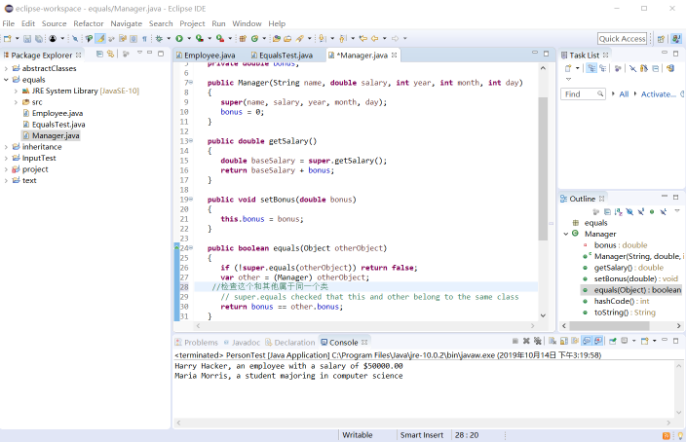
删除程序中Employee类、Manager类中的equals()、hasCode()、toString()方法,背录删除方法后的代码:
Employee类
|
1 2 3 4 5 6 7 8 9 10 11 12 13 14 15 16 17 18 19 20 21 22 23 24 25 26 27 28 29 30 31 32 33 34 35 36 37 38 39 40 41 42 43 44 45 46 47 48 49 50 51 52 53 54 55 56 57 58 59 60 61 62 63 64 65 66 67 |
package equals;
import java.time.*; import java.util.Objects;
public class Employee { private String name; //创建三个私有属性 private double salary; private LocalDate hireDay;
public Employee(String name, double salary, int year, int month, int day) { this.name = name; this.salary = salary; hireDay = LocalDate.of(year, month, day); }
public String getName() { return name; }
public double getSalary() { return salary; }
public LocalDate getHireDay() { return hireDay; }
public void raiseSalary(double byPercent) { double raise = salary * byPercent / 100; //定义局部变量 salary += raise; }
@Override public int hashCode() { //重写hashCode方法,使相等的两个对象获取的HashCode也相等 // TODO Auto-generated method stub return Objects.hash(name, salary, hireDay); }
@Override public boolean equals(Object obj) { // TODO Auto-generated method stub if (this == obj) return true; //快速测试几个类的根是否相同,即是否是同一个超类。这个if语句判断两个引用是否是同一个,如果是同一个,那么这两个对象肯定相等。 if (obj == null) return false; //如果显示参数为空,则返回false if (getClass() !=obj.getClass()) return false; //用getClass()方法得到对象的类。如果几个类不匹配,则它们不相等
//其他对象是非空Employee类 //在以上判断完成,再将得到的参数对象强制转换为该对象,考虑到父类引用子类的对象的出现,然后再判断对象的属性是否相同 Employee other = (Employee) obj; //测试字段是否具有相同的值 return Objects.equals(name, other.name) && salary == other.salary && Objects.equals(hireDay, other.hireDay); }
@Override public String toString() { //把其他类型的数据转为字符串类型的数据(toString方法可以自动生成) // TODO Auto-generated method stub return getClass().getName() + "[name=" + name + ",salary=" + salary + ",hireDay=" + hireDay + "]"; }
} |
Manager类重写之后代码如下:
|
1 2 3 4 5 6 7 8 9 10 11 12 13 14 15 16 17 18 19 20 21 22 23 24 25 26 27 28 29 30 31 32 33 34 35 36 37 38 39 40 41 |
package equals;
public class Manager extends Employee //子类:Manager类继承Employee类 { private double bonus; //创建私有属性bouns
public Manager(String name, double salary, int year, int month, int day) { super(name, salary, year, month, day); //子类直接调用超类中已创建的属性 bonus = 0; //给bouns赋初值为空 }
public double getSalary()//访问器 { double baseSalary = super.getSalary(); return baseSalary + bonus; }
public void setBonus(double bonus) //更改器 { this.bonus = bonus; }
public boolean equals(Object otherObject) //快速测试几个类的根是否相同,即是否是同一个超类 { if (!super.equals(otherObject)) return false; Manager other = (Manager) otherObject; //使用super.equals检查这个类和其他是否属于同一个类 return bonus == other.bonus; }
public int hashCode() //重写hashCode方法,使相等的两个对象获取的HashCode也相等 { return java.util.Objects.hash(super.hashCode(), bonus); }
public String toString() //把其他类型的数据转为字符串类型的数据(toString方法可以自动生成) { return super.toString() + "[bonus=" + bonus + "]"; } } |
EmployeeTest类代码如下:
|
1 2 3 4 5 6 7 8 9 10 11 12 13 14 15 16 17 18 19 20 21 22 23 24 25 26 27 28 29 30 31 32 33 34 35 36 37 |
package equals;
/** * This program demonstrates the equals method. * @version 1.12 2012-01-26 * @author Cay Horstmann */ public class EqualsTest { public static void main(String[] args) { Employee alice1 = new Employee("Alice Adams", 75000, 1987, 12, 15); Employee alice2 = alice1; Employee alice3 = new Employee("Alice Adams", 75000, 1987, 12, 15); Employee bob = new Employee("Bob Brandson", 50000, 1989, 10, 1);
System.out.println("alice1 == alice2: " + (alice1 == alice2));
System.out.println("alice1 == alice3: " + (alice1 == alice3));
System.out.println("alice1.equals(alice3): " + alice1.equals(alice3));
System.out.println("alice1.equals(bob): " + alice1.equals(bob));
System.out.println("bob.toString(): " + bob);
Manager carl = new Manager("Carl Cracker", 80000, 1987, 12, 15); Manager boss = new Manager("Carl Cracker", 80000, 1987, 12, 15); boss.setBonus(5000); System.out.println("boss.toString(): " + boss); System.out.println("carl.equals(boss): " + carl.equals(boss)); System.out.println("alice1.hashCode(): " + alice1.hashCode()); System.out.println("alice3.hashCode(): " + alice3.hashCode()); System.out.println("bob.hashCode(): " + bob.hashCode()); System.out.println("carl.hashCode(): " + carl.hashCode()); } } |
程序运行结果如下图:

测试程序2:
a) 在elipse IDE中调试运行程序5-11(教材182页),结合程序运行结果理解程序;
b) 掌握ArrayList类的定义及用法;
c) 在程序中相关代码处添加新知识的注释;
e)设计适当的代码,测试ArrayList类的set()、get()、remove()、size()等方法的用法。
程序代码如下:
|
1 2 3 4 5 6 7 8 9 10 11 12 13 14 15 16 17 18 19 20 21 22 23 24 25 26 27 28 29 30 |
package arrayList; import java.util.*; /** * This program demonstrates the ArrayList class. * @version 1.11 2012-01-26 * @author Cay Horstmann */ public class ArrayListTest { public static void main(String[] args) { // fill the staff array list with three Employee objects 用三个Employee类填充staff数组列表 var staff = new ArrayList<Employee>(); //动态数组,可以灵活设置数组的大小 staff.add(new Employee("Carl Cracker", 75000, 1987, 12, 15)); staff.add(new Employee("Harry Hacker", 50000, 1989, 10, 1)); staff.add(new Employee("Tony Tester", 40000, 1990, 3, 15)); // raise everyone's salary by 5% 将每个人的薪水提高5% for (Employee e : staff) e.raiseSalary(5); // print out information about all Employee objects 打印出所有Employee类的信息 for (Employee e : staff) System.out.println("name=" + e.getName() + ",salary=" + e.getSalary() + ",hireDay=" + e.getHireDay()); } } |
程序运行结果如下:

实验2:测试程序3
l 编辑、编译、调试运行程序5-12(教材189页),结合运行结果理解程序;
l 掌握枚举类的定义及用法;
l 在程序中相关代码处添加新知识的注释;
程序代码如下:
|
1 2 3 4 5 6 7 8 9 10 11 12 13 14 15 16 17 18 19 20 21 22 23 24 25 26 27 28 29 30 31 32 33 |
package enums; import java.util.*; /** * This program demonstrates enumerated types. * @version 1.0 2004-05-24 * @author Cay Horstmann */ public class EnumTest { public static void main(String[] args) { var in = new Scanner(System.in); System.out.print("Enter a size: (SMALL, MEDIUM, LARGE, EXTRA_LARGE) "); String input = in.next().toUpperCase(); Size size = Enum.valueOf(Size.class, input); //静态values方法返回枚举的所有值的数组 System.out.println("size=" + size); System.out.println("abbreviation=" + size.getAbbreviation()); if (size == Size.EXTRA_LARGE) System.out.println("Good job--you paid attention to the _."); } } //定义枚举类型 enum Size { SMALL("S"), MEDIUM("M"), LARGE("L"), EXTRA_LARGE("XL"); private Size(String abbreviation) { this.abbreviation = abbreviation; } public String getAbbreviation() { return abbreviation; } private String abbreviation; }//调用构造函数 |
运行结果如下:
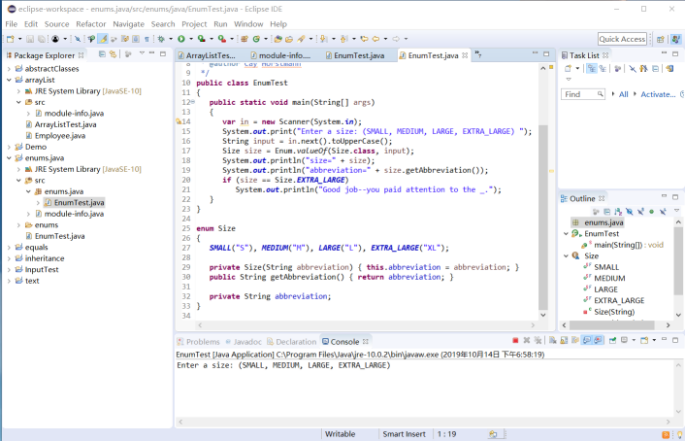
删除Size枚举类程序代码如下:
|
1 2 3 4 5 6 7 8 9 10 11 12 13 14 15 16 17 18 19 20 21 22 23 24 25 26 27 28 29 30 31 32 33 |
package enums; import java.util.*; /** * This program demonstrates enumerated types. * @version 1.0 2004-05-24 * @author Cay Horstmann */ public class EnumTest { public static void main(String[] args) { var in = new Scanner(System.in); System.out.print("Enter a size: (SMALL, MEDIUM, LARGE, EXTRA_LARGE) "); String input = in.next().toUpperCase(); Size size = Enum.valueOf(Size.class, input); //静态values方法返回枚举的所有值的数组 System.out.println("size=" + size); System.out.println("abbreviation=" + size.getAbbreviation()); if (size == Size.EXTRA_LARGE) System.out.println("Good job--you paid attention to the _."); } } enum Size { SMALL("S"), MEDIUM("M"), LARGE("L"), EXTRA_LARGE("XL"); private Size(String abbreviation) { this.abbreviation = abbreviation; } public String getAbbreviation() { return abbreviation; } private String abbreviation; }//调用构造函数 |
程序运行结果如下:

测试程序4:录入以下代码,结合程序运行结果了解方法的可变参数用法
|
1 2 3 4 5 6 7 8 9 10 11 12 13 |
public class TestVarArgus { public static void dealArray(int... intArray){ for (int i : intArray) System.out.print(i +" ");
System.out.println(); } public static void main(String args[]){ dealArray(); dealArray(1); dealArray(1, 2, 3); } } |
程序运行结果如下:

实验3:编程练习:参照输出样例补全程序,使程序输出结果与输出样例一致。
程序代码如下:
|
1 2 3 4 5 6 7 8 9 10 11 12 13 14 15 16 17 18 19 20 21 22 23 24 25 26 27 28 29 30 31 32 |
public class Demo { public static void main(String[] args) { Son son = new Son(); son.method(); } } class Parent { Parent() { System.out.println("Parent's Constructor without parameter"); } Parent(boolean b) { System.out.println("Parent's Constructor with a boolean parameter"); } public void method() { System.out.println("Parent's method()"); } } class Son extends Parent { //补全本类定义 Son() { super(true); //调用父类有参构造 System.out.println("Son's Constructor without parameter"); } public void method() { System.out.println("Son's method()"); super.method(); } } |
程序运行结果如下:
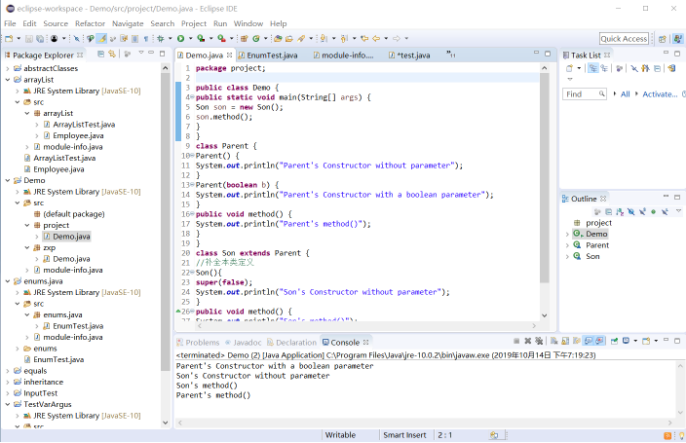
第三部分:实验总结
在本次实验中,我们是在前两周学习的基础上融会贯通,又加深并掌握了关于继承的相关知识和实验技能.但是在完成老师布置的自主实验时,因为知识掌握能力的不足,写程序的时候思维逻辑并不是很清晰,不过还是完成了题目要求的内容。通过这一个多月Java的学习,自己对程序语言又有了更深的理解,每次试验后,自己的反思和老师的点评,还有学长和同窗的指教都给了我很大的提升。